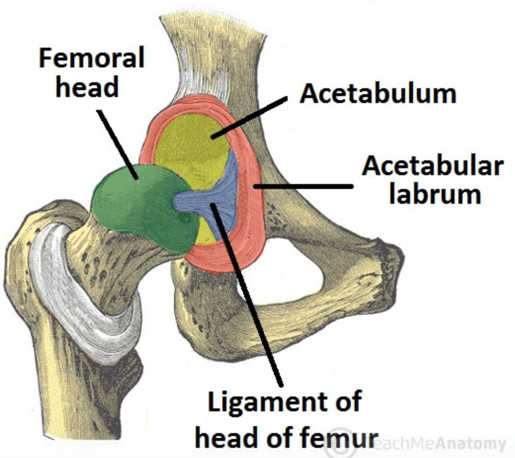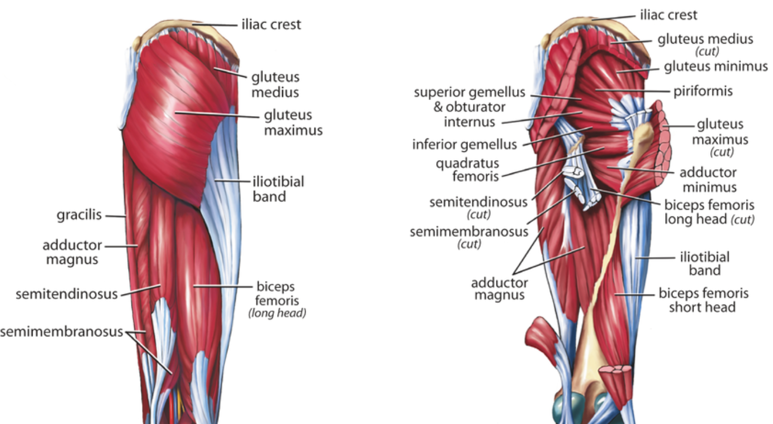Total Hip Replacement
What is Total Hip Replacement?
A total hip replacement (THR), or total hip arthroplasty (THA) is a surgical procedure to replace a worn-out, or damaged hip joint. An orthopedic surgeon removes the damaged femoral head (Top part of your thigh bone), and the damaged cartilage from your acetabulum (socket). The damaged femoral head is replaced with a metal or ceramic ball and the damaged acetabulum is replaced with a metal socket. A spacer is also placed between the new ball and socket in order to allow for smooth movement at the hip joint.

Hip Anatomy
The hip is a ball-and-socket joint that is formed by the acetabulum of the pelvis (the socket), and the femoral head (the ball) of the femur (thigh bone). These bony surfaces are covered with articular cartilage which allows the joint to move smoothly. The hip joint is stabilized by several ligaments and muscles. Ball-and-socket joints are the most mobile joints in the human body, meaning these joints can move in all planes of motion.


Who is Appropriate for Total Hip Replacement?
Total hip replacements are most often performed due to osteoarthritis (wear-and-tear on the joint). Rheumatoid arthritis (an autoimmune disease that can damage the cartilage), avascular necrosis (decreased blood supply to the hip joint), fracture, and hip disorders in childhood are other causes for a total hip replacement. Surgery is recommended for those that have difficulty sleeping, walking, or performing daily activities due to pain.
Before and During Surgery
Prior to surgery, your doctor may recommend prehab (Physical therapy before surgery). Prehab before joint replacement surgery has been shown to improve functional outcomes and patient satisfaction after surgery. For a total hip replacement, this would include glute (buttock muscles) strengthening, quad (muscle on the front of thigh) strengthening, and hip range of motion exercises. Before surgery, it is also important to assess your home set up. You may want to consider having a first floor set up if you live in a two-story home, remove any clutter or throw rugs from the floor, and adjust your bed height if it is taller than a normal sitting surface.
You will be put to sleep using general anesthesia or sedated and receive spinal anesthesia. Nerve blocks are also commonly used to reduce pain after surgery. An incision is cut either posteriorly, anteriorly, or laterally depending on your surgeon’s preference. The damaged bone is removed and the implants are placed. Your joint will then be manipulated (moved around) to ensure proper fit and a full range of motion.
After Surgery
Most hip replacement surgeries require an overnight stay in the hospital. This allows your surgeon to ensure proper pain control and that you can safely mobilize prior to returning home. The pain will be managed using medication and frequent icing. Ice will also help to reduce inflammation and swelling after surgery. A physical therapist will visit you in the hospital to perform walking, transfers, and post-op exercises. An occupational therapist will visit you in the hospital to provide education on bathing, dressing, and toileting. You will most likely have to walk using an assistive device (rolling walker or cane), use an elevated toilet seat to avoid sitting too low, and use tools such as a Reacher, shoehorn, and long-handled sponge to assist with ADLs (activities of daily living). These are needed to ensure you are able to follow your post-op precautions and avoid dislocation of your new hip joint. Post-op precautions following a total hip replacement vary depending on the location of your incision (posterior, anterior, or lateral). Your surgeon and rehab team will discuss these with you several times before and after surgery.
Risk factors after surgery include infection, blood clots, and dislocation. Precautions by your surgeon and physical therapist will be taken to avoid these at all costs.
How can a Physical Therapist Help with a Total Hip Replacement?
After you are discharged home, your surgeon will recommend home health physical therapy or outpatient physical therapy depending on your needs. In the early post-op phase, physical therapy will focus on weaning from an assistive device when walking, improving hip range of motion while maintaining hip precautions, pain control, decreasing swelling, and glute and quad strengthening. Beginning strengthening as soon as possible after surgery will help with tasks such as being able to get your leg on and off the bed without assistance, getting in and out of the car, and negotiating steps. As you progress, your physical therapist will begin to “Fine-tune” gait mechanics in order to avoid limping, work on improving your balance, and improve functional strength for tasks such as standing from a chair and kneeling.
No one patient has the same goal following total hip replacement. Therefore, your physical therapist will work with you on setting individualized goals that will assist you in returning to your desired lifestyle. Physical therapy following a total hip replacement generally lasts 4-12 weeks depending on your individual recovery and goals.



